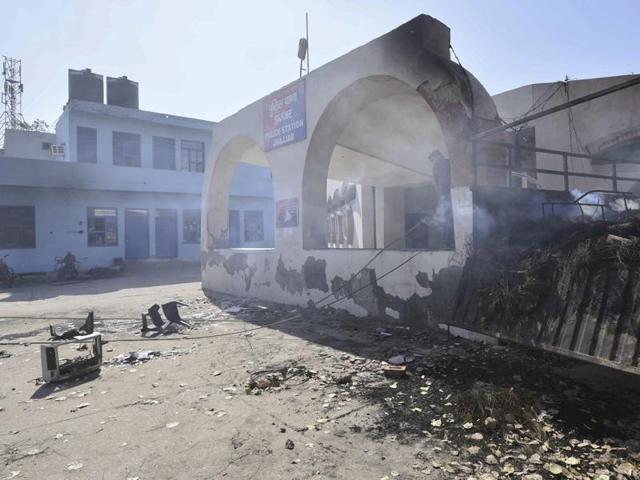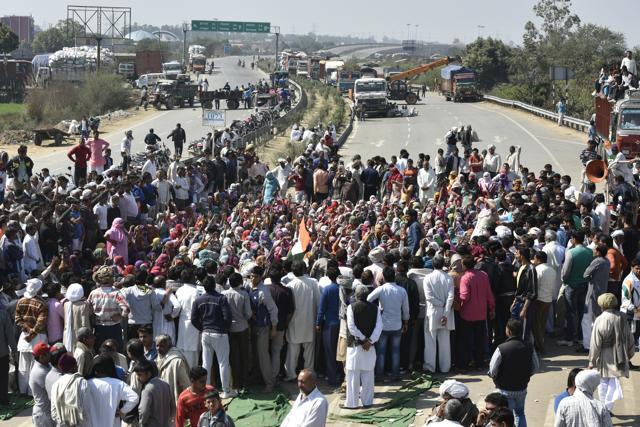Reasons behind the madness: What accounts for the Jat stir
The main factor that underpins the current stir, which has claimed the lives of nearly 20 people, is the fact that no political party has been able to co-opt this community; equally, the Jats have not managed to hitch their wagon, and their aspirations, to lawmakers in Delhi.
The Jats have been on the warpath for government jobs to be reserved for them; in that desire, they are no different from many other groupings, even if they are more affluent than most. But what makes them take to the streets?

The main factor that underpins the current stir, which has claimed the lives of nearly 20 people, is the fact that no political party has been able to co-opt this community; equally, the Jats have not managed to hitch their wagon, and their aspirations, to lawmakers in Delhi.
Why Delhi, no party can claim to have the Jats as its support base — not even the Indian National Lok Dal — even within the boundaries of a state. A deft political touch that could have softened a community’s anger has been missing in this case.
Read: Jat protest: ‘Reservation killed our sons and brothers’

Contrast this with the ordinance on reservations for the Marathas in jobs and educational institutions of Maharashtra. The ordinance was first passed by the Congress-NCP government but the Bombay high court gave a stay order on it. Subsequently the new Maharashtra government cleared it. What is to be noted is that the whole thing happened without any blocking of roads and cancelling of trains. The reason is that the Marathas have been integrated into mainstream politics. Alternative modes of protest such as sitting on rail tracks are not quite built into the Maratha ethos. Remember YB Chavan?
For a prominent landowning caste to have state patronage, its demands need to be articulated by a party. Else it starts a movement that acquires a domain of its own and begins to grow a certain autonomy as has been happening with the Jats and had earlier happened with the Gujjars.
Remember that the Jats have rebelled against the State from the days of the Mughal empire. So did the Rajputs and the Marathas: They were cases of a minor state authority coming into conflict with a hegemonistic one that sought to subsume all others into it, while the rebellion of the Jats was a peasant revolt.
To top it all, the Jats have not had a recognised supreme leader (for the Jats in Haryana, Chotu Ram was perhaps the last. In western UP it was Charan Singh. Devi Lal and Bansi Lal cannot be accorded ‘supreme leader’ status). The net result of this is that they have not had a structured system of political loyalties. Hence they are different from the Yadavs of Bihar and UP, or the Lingayats and Vokkaligas of Karnataka.
But there are also other explanations for the nature of their rebellion.
Read: 72 men, 11 machines, a city on fire: Rohtak during Jat stir

Writing in a prominent newspaper, Christophe Jaffrelot, who is an expert in caste matters, has gone into a whole host of reasons as to why the Jat movement for reservations has taken place and taken place now. The reasons given are familiar: low wages in the farm sector (though it is not clear as to how this applied to the Jats because they are a land-owning community), their inability to get good private-sector jobs, particularly in the IT sector, because of their being less than proficient in English (he has compared this movement to that of the Patels in Gujarat, even though the English factor does not apply across the board in that case), etc. He has also said the number of government jobs and those in the public sector have much reduced over the past 25 years (in that case, why agitate over them anyway?). But since he is fairly distinguished in his field, he deserves to be taken seriously and each of the points he has made, I am sure, contains a grain of truth.
The dominant political groups of the south, also land-holding like those in the north, have always aligned themselves with electoral politics. Hence there have been a Brahmananda Reddy in Andhra Pradesh, a Nijalingappa in Karnataka, or a Deve Gowda, also in Karnataka. In Tamil Nadu the fight for state largesse got enmeshed in other kinds of movements, and hence acquired a distinct identity of its own. In Kerala because of the presence of the Left, caste conflict acquired the face of class conflict.
Read: Reports of 10 rapes on NH-1 during Jat agitation false, says police
Commenting on the caste architecture the political scientist Paul Brass has said: “Although the lowest castes and tribes have provided a critical support base for the Congress, for the most part politicians from these groups have been dependent upon more powerful upper caste leaders” (The Politics of India since Independence). A truly perceptive observation because this has been a factor in composing social conflicts and preventing political turmoil. But unfortunately this did not work in some pockets, particularly among the wealthier ones. This agitation needs to be seen in that context.
.





